The Northern California- San Francisco area boasts an amazingly complex patchwork of ten different rail options designed for commuters. Most are separately owned and operated. We decided to see if the system can all work together............
San Jose, California: As pre-teenagers, my closest buddy and I liked to ride our bikes to the Conway Yards near Pittsburgh, PA, to watch trains. Tony and I still get together periodically, and on this visit, decided to experience steel wheels on steel rails in Northern California and Nevada.
Our objective on the first day was to utilize six modes of Bay Area transit systems and reward ourselves with lunch at the Top of the Mark, the famous restaurant and bar atop the InterContinental Mark Hopkins Hotel, at the crest of Nob Hill in San Francisco.
This was a suitable destination for rail enthusiasts as Mark Hopkins was one of the Big Four (Hopkins, Leland Stanford, Collis P. Huntington, and Charles Crocker) responsible for the construction of the Central Pacific Railroad from Sacramento to Ogden, UT, completed by the driving of the Golden Spike in 1869.
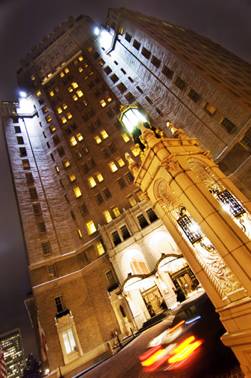
The InterContinental Mark Hopkins Hotel
The least complicated way to reach the Mark Hopkins Hotel would be to jump into our rented Mercury Grand Marquis and drive north on nerve-wracking Highway 101 (Bayshore Freeway), fight city traffic up to Nob Hill, and pay the $57.00 valet parking fee at the hotel.
Instead, we decided to test the capabilities of the public transportation system of the Bay Area, with the emphasis on public transit rail service.
The Comfort Suites San Jose Airport is located on First Street, on the light rail lines of the Valley Transit Authority. Two lines traverse this route, the Alum Rock-Santa Teresa Line, and the Mountain View-Winchester Line. This line will take us directly to the train station and transit center.
Leaving our hotel at 9:45am, we walk one block to the light rail stop at the corner of Gish Road and First Street to await the next Mountain View Winchester train; hoping one will get us to the CalTrain Station in time for a 10:40am departure. Two Alum Rock-Santa Teresa trains come by, then a Mountain View Winchester train. However, after stopping at Gish, the operator puts up the Out of Service destination sign, and evicts the single passenger who is riding the car.
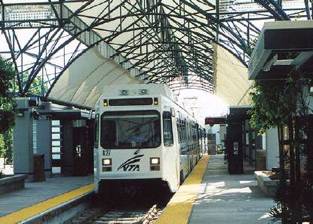
Valley Transit Authority Kinki-Sharyo light rail vehicles. (Made in Japan.)
Finally a Mountain View Winchester train arrives, in service, and in a few minutes we arrive at the San Jose Diridon Station. This was formerly the Southern Pacific Railroad Cahill Street Station, but was renamed in 1994 after a retired Santa Clara County Supervisor, Rod Diridon, after the station’s much appreciated restoration was complete.
There was temporary confusion at the platform as to how to reach the CalTrain Station, but we could see the tops of passenger coaches on the other side of a fence separating the light rail station from the train station, so we crossed the tracks on a walkway, and headed for a pedestrian tunnel labeled in fine print, “To CalTrain Station”. This tunnel has been here since the station opened in 1935. It has been expanded and the end opened up to gain access to the light rail platform. There is a CalTrain ticket dispensing machine at the entrance to the tunnel. We obtain tickets at the Senior Citizen fare, $3.00 per person for the three zones encompassing San Jose and Millbrae, and walk to the ramp assigned for the next CalTrain departure.
Other passengers are awaiting the arrival of the CalTrain, so we know we have reached the right location. The train we are waiting for originates at the Tamien Station, 7 minutes south of Diridon, and it comes clanging in at 10:40am. We board and find seats during the brief stop, and we are soon on our way to our next interchange point, with BART, the Bay Area Rapid Transit station at Millbrae, to the north.
We are quite pleased with our success, as it took us only 55 minutes from our hotel lobby to our seats aboard a CalTrain, a distance of 4.4 miles by highway. But saving time is not our goal; testing the public transportation is. Driving to the station would have been an exercise in futility, as there would be no parking spaces available by this time of day. The cab fare from the train station to the hotel would have been $15.00 including tip, whereas the VTA trolley fare was only 75 cents per person. Will this prove to be a time-versus-money situation? We can hope that this adventure won't cost any more than the $57.00 hotel parking fee at the Mark Hopkins.
Our Cal Train is an all-stops local and Millbrae is the 15th stop after leaving Diridon. It takes 61 minutes to cover 36 miles.
We arrive on time at 11:41am and find that the BART station is conveniently adjacent to the CalTrain Station. There is a BART ticket vending machine on the CalTrain platform. We quickly purchase two tickets at $4.25 each and go through an automated turnstile. On the other side a BART train is waiting for us.
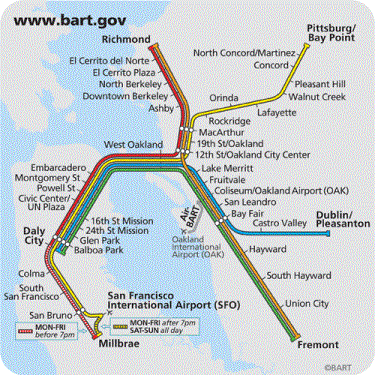
Millbrae is the southernmost BART station on the west side of the Bay, and offers weekday only service as far as Daly City. From Daly City onward service is seven days a week. This route runs underground for the most part, at speeds up to 80mph, and the noise level can be quite high inside the tunnels. The cars were manufactured in the late 1960s and are kept cosmetically attractive and operationally reliable.
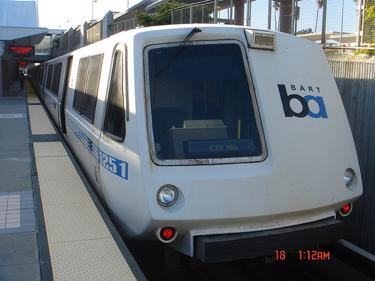
Bay Area Rapid Transit, BART, train.
We meet the 11:48am BART departure and by 12:19pm we're in downtown San Francisco at the Montgomery Station, across Market Street from the Hyatt Regency Hotel.
The California Street Cable Car line begins right outside the Hyatt Regency, and at $5.00 per person (no discounts) we are whisked to the top of Nob Hill in just a very few minutes.
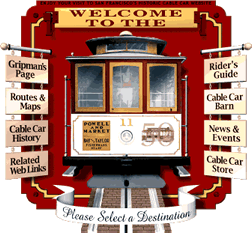
The advantage of the California Street line is that it isn't crowded; most tourists ride the Powell Street line to Fisherman’s Wharf.
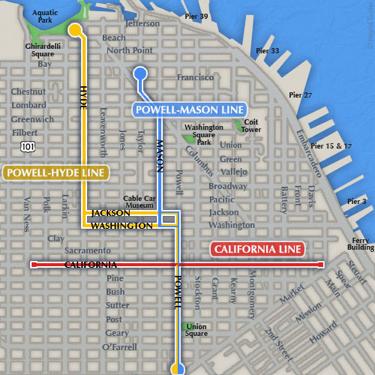
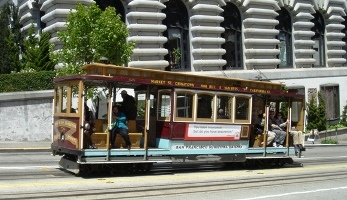
California Street Cable Car. Photo by Ted Blishak
By 1:00pm we are ushered to a table at the elegant Top of the Mark, overlooking Nob Hill, with the Golden Gate in the distance. The Episcopalian Grace Cathedral dominates the view on the left, with the Pacific Union Club in the right foreground, surrounding Huntington Park.
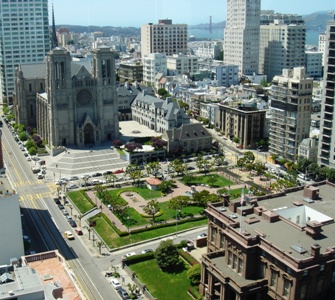
Nob Hill from the Top of the Mark. Photo by Ted Blishak
After an excellent luncheon, we considered riding the Powell Street cable car to Fisherman’s Wharf, but every car rumbling up the hill from Market Street was packed, with standees hanging out on all sides. The easy way was to take the California Street car back down (for another $5.00 per person) to the Hyatt Regency on Market Street.
From here we would await an F-line Vintage Trolley Car to take us to the Stockton Street bus stop, where we could pick up a San Francisco Muni bus to the Cal Train Station.
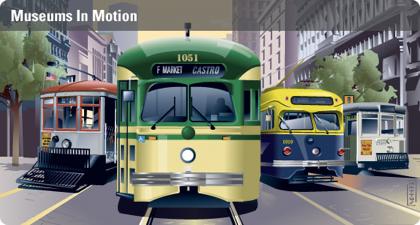
Enjoy your ride! The rails of the cable car system, the F-line, and the future E-line form a "steel triangle" in northeastern San Francisco.
We boarded an ancient trolley from Milan, Italy. This type of streetcar was designed by Cleveland transit leader Peter Witt and ran in many US cities. Milan, Italy, built hundreds of Peter Witts in 1928; some are still running today. Muni maintains eleven of them meet the huge F-line rider demand.
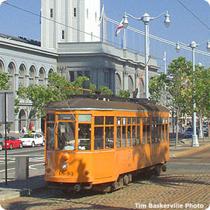
Milan Peter Witt car next to Ferry Building.
The ride was exhilarating -- but too short -- to Stockton Street, but it was easy to find a Muni bus from there to the CalTrain Station, as every bus heading south on Stockton stops at or near the station. The F-Line fare was $2.00 and included a transfer for the Stockton buses.
Our objective was to board the 4:09pm CalTrain Baby Bullet, scheduled to make the run from San Francisco to San Jose in 57 minutes, with only four intermediate stops. Feeling confident of his mastery over ticket vending machines, Tony chose to purchase his $3.75 4-zone Senior Fare with a $20 bill, and was quickly weighted down as he received 16 silver dollars and one quarter as change!
Instead of the advertised Baby Bullet equipment, our train had the older, traditional double- deck gallery coaches. When it pulled out at 4:09pm, there were standees in our coach.
We'd hoped to experience the absent rakish red-and-gray engines pulling bi-level Bullet cars, equipped with café style seating, providing tabletop space with electrical outlets.
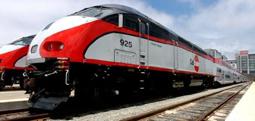
CalTrain Baby Bullet, new version.
However, we were not disappointed with the trip, which was over in record time. Never before had I passed through my old home town of Menlo Park, 1.1 miles, in 62 seconds, only 64mph average speed since we were slowing down for a station stop in adjacent Palo Alto. On El Camino Real at rush hour, it could easily take 20 minutes by car or bus.
We arrive into San Jose three minutes behind schedule, at 5:09 pm. Taking the short walk through the tunnel to the VTA station, we pulled our 75 cent tickets from the VTA vending machine, and a Winchester Mountain View train slowed to a stop. In a few minutes we were detraining back at Gish, with just a short walk to the Comfort Suites in time for cocktail hour. We toasted each other, having had taken on public transportation -- and won! Our total fare of $24.50 per person came out to be less than the Mark Hopkins Hotel parking fee alone, not to mention the $25.00 worth of gasoline we saved.
Sidebar:
Caltrain will cut service in October, raise fares in January
By Mike Rosenberg
San Mateo County Times
Updated: 06/04/2010 06:24:27 PM PDT
Caltrain intends to cut service in October and raise fares in January and may create a "wind down plan" to prepare for a possible shuttering of the railroad in 2012, officials said Thursday.
The Cal Train has been an amazing success story in its lengthy transformation from an ancient Southern Pacific legacy local train service into a contemporary high speed commuter service. Besides the new equipment there have been roadbed improvements, including third track passing sidings, improved signaling, and even talk of electrification. Unfortunately, due to the dreary financial meltdown of the State of California, Cal Train faces cutbacks in mid-day and weekend service this fall. Electrification is now just a pipe dream and higher speeds are no longer just around the corner.
Our 7th rail transportation option in the Bay Area is Amtrak California, with its Capitol Corridor from San Jose to Sacramento and its San Joaquins from Oakland to Bakersfield.
The 8th option is the Altamont Commuter Express (ACE) service from San Jose to Stockton. Their trains are scheduled inbound for the morning rush to San Jose, returning from San Jose to Stockton in the afternoon. We had hoped to do a circle trip to Stockton, returning on Amtrak. However, taking the first afternoon train from San Jose to Stockton would have left us stranded there, as the Altamont Commuter Express does not make a connection with a returning Amtrak San Joaquin.
We do, later, find a way to experience ACE as the first portion of a trip from San Jose to Sequoia National Park. We could have driven the approximately 250 miles in 5 to 6 hours. But since we wanted to experience public transportation we start out the leisurely way.
We taxi to the San Jose Diridon Station to board the 12:05pm departure of the Altamont Commuter Express. Our tickets are $11.75 each. The ACE route crosses Altamont Pass and scenic Niles Canyon, the route of the original, pre-Amtrak, California Zephyr, an easy two hour and 10 minute ride. The Toronto GO! style cars, painted red white and blue, are comfortable and the scenery magnificent.
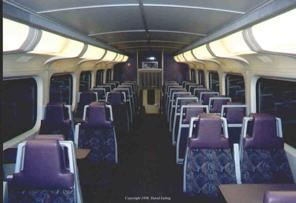
We plan to connect with a southbound Amtrak California San Joaquin train. The only inconvenience with this connection is that ACE stops at one station in Stockton and Amtrak stops at another station, a 10 minute bus ride away. Amtrak, however, has made it easy to make a connection to their San Joaquin service, by scheduling a shuttle bus from the ACE station to the Amtrak station. Disappointingly, the shuttle did not show up for the half dozen or more passengers waiting for it under the "Amtrak Shuttle Stops Here" sign posted on a nearby lamp pole. Fortunately an ACE security guard noticed the crowd awaiting the late shuttle and restlessly anticipating their missed connection to Amtrak. He volunteered to transfer all of us to the Amtrak Station, taking two trips with his small Chevrolet SUV. He was very friendly and helpful, though noticeably annoyed at the lack of reliability of the Amtrak Shuttle driver, whom he said often missed his run between the two stations.
. 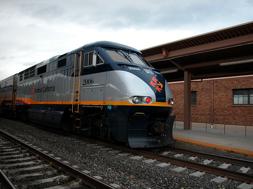
We all arrived at the Stockton Amtrak station with ample time to meet the southbound San Joaquin to Fresno. The streamlined General Motors engine rolled in on time and we boarded and found seats at a table for four on the upper level of the bi-level California Cars.
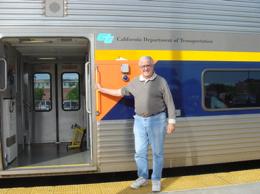
Tony Stakis and a California Car. Photo by Ted Blishak
We were heading on to Fresno to pick up a Lincoln Town Car for the remainder of our journey, with stops at Sequoia National Park, Death Valley, the Bristlecone Pine forests of the White Mountains, and Reno. The San Joaquin got us to Fresno on time at 5:16pm. A bit slower than driving, but more relaxing.
Hertz showed up at the Amtrak Station with a Lincoln Navigator for us, as they were out of Town Cars. We accepted this complimentary upgrade with pleasure, and the Navigator proved to be more than adequate for the remainder of our journey through the train-trackless mountains and vast desert valleys of California.
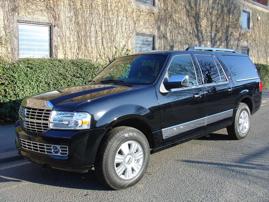
No steel wheels here. Our 11th mode of transportation!
After a few days of being pampered with the big, comfortable Navigator, we ended our drive in Reno, and enjoyed the interesting and historical Harrah's Automobile Museum. We stayed overnight in order to meet the following morning's westbound Amtrak California Zephyr.
The restored and modified Reno Station has an elevator to take passengers and their luggage two levels down to the underground waiting room and boarding platform. There are several short term parking spaces on the street, to be used only for loading and unloading. The nearest long-term parking is at the Reno Airport east of town. Fortunately for us, the Hertz return counter is located inside Harrah's, making it easy to return our car and walk across the street to the station.
The Amtrak California Zephyr, our travel mode number 9, is an intercity Superliner. It descended into the two-mile trench excavated through downtown Reno to facilitate street traffic, which used to be blocked with stopped Amtrak trains and lengthy freight trains running across downtown streets.
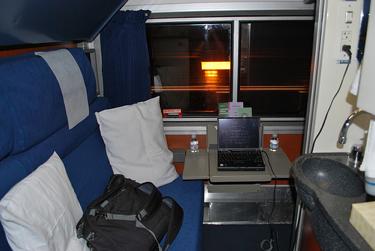
Settling into our Superliner Bedroom, we proceeded, in solid comfort, to retrace the steps of the ill-fated Donner Party of 1848, who were trapped by deep snow at Donner Lake, with the stormy eastern scarp of Donner Pass looming over them. A century and a half later, we are delivered to Sacramento practically before we know it, in comfort and safety.
 
The next morning found us at the entrance to the California Railroad Museum, just a short walk from the Amtrak Station and the three hotels that cater to Sacramento Old Town visitors, the Vagabond Inn, the Holiday Inn, and the Delta King, a paddle wheel river steamer converted to a floating hotel.
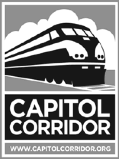
Once we exhausted the exhibits at the rail museum, we caught the next of many Capitol Corridor Amtrak California trains that run between Sacramento and San Jose. The Capitols, our travel mode 10, are a fast and smooth alternative to zipping along congested Interstate 80, hemmed in by trucks and cars driving at 70-plus. We soon found ourselves disembarking at Oakland Jack London Square, in time for a family gathering at Scott's Seafood Restaurant on the Oakland Estuary, a fitting close to week of adventure.
|

